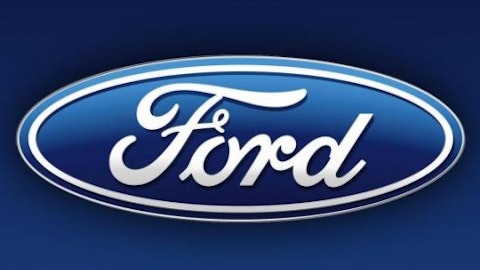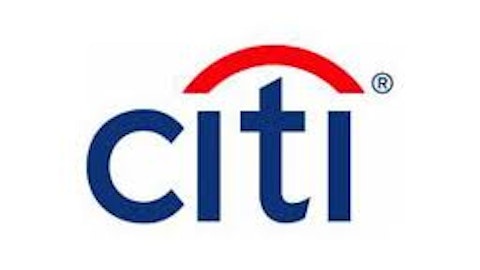For the past year or so, I have been contemplating buying Ford Motor Company (NYSE:F). I believe the company is really quite undervalued against the rest of its sector and the wider market. However, there is one thing that worries me: the company’s debt.
Debt level
| $US Millions | 2007 | 2008 | 2009 | 2010 | 2011 |
| Net debt | $117,732 | $114,244 | $88,967 | $68,418 | $63,722 |
| Long-term debt | $107,478 | $90,224 | $89,073 | $62,324 | $59,177 |
| Cash & cash equivalents | $50,798 | $39,952 | $43,474 | $35,570 | $35,766 |
| Total Debt | $168,530 | $154,196 | $132,441 | $103,988 | $99,488 |
This table only goes to 2011, but the 2012 picture looks the same as 2011. During 2012, Ford saw a 10% rise in its long term debt during 2012, up to $66 billion, and total debt grew 5% to $105 billion, while cash and equivalents remained static. Net debt is around $70 billion. As Ford Motor Company (NYSE:F) has a market capitalization of $47 billion and net debt of $70 billion, the company has a gearing level of roughly 140%.
Is this too much?
Looking at the table above, Ford Motor Company (NYSE:F) appears to be working hard to bring down is level of debt. Indeed, total debt was $160 billion in 2007 and has now fallen to nearly $105 billion (that is a fall of 35%), which is not a massive reduction. However, when the level of gearing is taken into account the difference becomes startling.
In 2008, Ford Motor Company (NYSE:F) was trading at a gearing level 10 times. Now, Ford it is trading on a gearing level of 1.4 times. In addition, as shown below, the company’s level of debt to EBITDA has also fallen dramatically.
So Ford Motor Company (NYSE:F) is working hard on reducing its debt burden, but how does it compare to other companies in its sector?
Comparison
This chart compares the differences in net debt between the major US auto makers, Ford, GM , as well as Volkswagen (NASDAQOTH:VLKAY), which I believe is the best auto maker outside of the US.

This highlights the dramatic fall in Ford’s net debt over the past five years. On the other hand, the chart highlights the rise in Volkswagen’s net debt. According to this data, GM has had a net cash position since mid-2008.
Volkswagen’s debt is growing, surpassing Ford’s in dollar terms back in 2011. However, Volkswagen is the larger company, (about twice the size of Ford, with a market cap of approximately $100 billion to Ford’s $47 billion) so, in theory, it can handle the larger amount of debt. Although as I show below, Volkswagen’s debt is costing the company more and more of its EBIT in interest.

Presented in chart form, the reduction in debt becomes obvious.
Ford Motor Company (NYSE:F) has been paying down and reducing its long term debt exposure over the past five years, whilst keep its cash balance relatively stable, allowing the company to slowly improve its net debt position.

A more in-depth view of GM’s balance sheet shows the company’s strong net cash balance. However, towards the end of the chart in 2011, the company has been slowly increasing its long term debt exposure.
Cash and equivalents have remained in a tight range after they grew rapidly in 2008, which offset the majority of the company’s debt and threw GM into a net cash position.

Compared to the relatively stable balance sheets of both Ford and GM, Volkswagen’s balance sheet debt is rapidly rising. Cash and equivalents have remained stagnant like at Ford; however, unlike Ford, Volkswagen’s net debt position is deteriorating rapidly, putting strain on the company’s balance sheet.
As I have mentioned, Volkswagen is bigger than Ford, so it is able to sustain a higher level of net debt; but when company net debt is compared to EBITDA ,both Ford and Volkswagen appear to be on a level playing field.

On a net debt to EBITDA basis, Volkswagen and Ford are on the same level, despite Volkswagen’s bigger market cap. Ford’s earnings are growing, while Volkswagen’s are shrinking, which is forcing the net debt to EBITDA ratio to fall.
The higher debt ratios in 07-09 are attributable to lower earnings throughout the credit crunch. Ford’s earnings have grown strongly over the past several years, and coupled with the company’s debt reduction this improved the company’s debt profile and sustainability.
On the other hand, Volkswagen’s earnings have grown slowly, almost in-line with the company’s increasing debt, which has given the company a stagnating net debt to EBITDA ratio.
So, how sustainable are debt costs?

Financing costs have fallen throughout the market over the past year, as interest rates fall and corporate bond yields decrease. Indeed, financing rates across these three companies have dropped between 2010 and 2011, making borrowing cheaper. Ford has made use of this by reducing debt, while GM has marginally increased debt, and Volkswagen has significantly increased debt.
The comparison between debt issuance and reduction is staggering.

Ford has been reducing debt in large quantities every year since 2008. Volkswagen has been increasing debt at regular amounts of $10 billion a year since 2008 apart from 2010, when it brought back a small amount. GM’s large debt issue in 2009 was a debt refinancing, resulting in no real increase in the company’s net debt position.
Conclusion
So overall, Ford’s debt has been a problem in the past, but compared to its competitors the company is not in any real difficulty. Ford is reducing its debt pile, while competitors are increasing their debt, which makes Ford look like the better company.
In addition, Ford’s debt is relatively low in relation to the company’s EBITDA, and financing costs are only around 10% of the company’s EBIT.
All in all, Ford’s debt seems manageable, and GM has a net cash balance. Volkswagen is rapidly increasing its debt, and this could affect the company in the future.
Data Source: Saxo Capital Markets, Marketwatch
The article Can Ford Sustain Its Debt? originally appeared on Fool.com.
Copyright © 1995 – 2013 The Motley Fool, LLC. All rights reserved. The Motley Fool has a disclosure policy.



